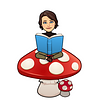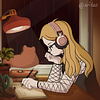Take a photo of a barcode or cover
I was a bit disappointed when I first started this book because I made the mistake of thinking it was a sequel :(. But I was intrigued by the focus on Tool and some new characters to explore another aspect of the world portrayed in the first.
adventurous
challenging
dark
emotional
mysterious
tense
medium-paced
Plot or Character Driven:
A mix
Loveable characters:
Yes
Diverse cast of characters:
Complicated
I can't think besides setting and one character how this book fits with book 1. I'm actually kind of confused. I hope book 3 ties it all together.
The Drowned Cities is listed on some sites as the second in the Ship Breaker series. It’s a novel set in the same post climate change world as Ship Breaker rather than a “Book 2”.
So don’t feel you have to have read Ship Breaker to get the full experience. The Drowned Cities shares some locations and one character with Ship Breaker - the half-man Tool.
Quality fiction
The Drowned Cities is published in Australia by Atom, Hachette’s Young Adult brand. To adult readers I would like to stress that this really has no impact on your enjoyment as an experienced or mature reader - it’s just quality fiction.
A future dystopia or comment on current events
With The Drowned Cities Bagicalupi builds upon and expands his vision of a dystopian future. Like Ship Breaker the theme and content mirrors or comments indirectly( I never feel as though Bagicalupi is preaching) upon present day issues. Ship breaker concentrated on a characters whose living was made stripping great containerships – a modern day inspiration, was no doubt something similar to The Chittagong Ship Breaking yards in Bangladesh.
The Drowned Cities’ theme centres squarely on the horrors of low scale internecine warfare in failed states and the sad reality of child soldiers and child victims of war. Bagicgalupi brings the tale closer to home with his setting – The Drowned Cities being the flooded remnants of the eastern states of North and South Carolina.
The Tale
Mahlia and Mouse are War Maggots, orphans or refugees taken in by Dr Mahfouz who administers medical treatment to the families of Banyan Town. Mahlia is a mixed raced daughter of a Chinese Peacekeeper and American/Drowned Cities mother, she’s had her right hand cut off by the Army of God due to this fact.
Mouse is a country boy with a talent for dodging bullets. While their situation isn’t ideal i.e. the town’s folk distrust her, it’s relatively safe. Until that is, Tool,an escaping half-man, a genetic augmentation, draws militia pursuers to their quaint little piece of post apocalyptic hell.
What ensues is part comment on the stupidity and futility of war but also on the strength of friendships borne out of survival.
Good Characterisation
Mahlia is the star of the story and I find her depiction as a strong female character particularly realistic and refreshing. She’s a child of war, a survivor and her strength shines through, in her dedication to her friends and her will to go on.
She displays cunning in her battles against forces that are physically stronger than her and is a refreshing hero in that she doesn’t need a gun or kick-arse martial arts moves to be strong.
We also get a better understanding of Tool as a rare breed of half-man, one that has overcome his genetic tendencies and training to obey his masters.
I also saw the depictions of the various militias in the book as comments on the some of the extremes of current American politics or political ideologies both in terms of religion and patriotism/nationalism. No doubt some American readers might find Bagicgalupi’s future imaginings a little pointed.
Concerns?
The book deals with some fairly mature content. I never felt as though Bagicgalupi was playing to the more violent aspects of the book though. There’s death and dismemberment but is well handled, repectfully depicted and fits well within the context of the world that’s been created.
I can see Ship Breaker and The Drowned Cities as good jumping off points for discussions in a class mixing literature/reading with social studies.
The depiction of sex within the book, such that it is, is handled “off screen”.
Judgement
A good addition to Bagicgalupi’s vision of a world in decline or crawling out of one. There’s violence, poverty and calamity, but there’s also hope. There’s always a sense that the protagonists can prevail - not without consequences mind you, but that it is possible.
This book was provided to me by the publisher at no cost to myself
So don’t feel you have to have read Ship Breaker to get the full experience. The Drowned Cities shares some locations and one character with Ship Breaker - the half-man Tool.
Quality fiction
The Drowned Cities is published in Australia by Atom, Hachette’s Young Adult brand. To adult readers I would like to stress that this really has no impact on your enjoyment as an experienced or mature reader - it’s just quality fiction.
A future dystopia or comment on current events
With The Drowned Cities Bagicalupi builds upon and expands his vision of a dystopian future. Like Ship Breaker the theme and content mirrors or comments indirectly( I never feel as though Bagicalupi is preaching) upon present day issues. Ship breaker concentrated on a characters whose living was made stripping great containerships – a modern day inspiration, was no doubt something similar to The Chittagong Ship Breaking yards in Bangladesh.
The Drowned Cities’ theme centres squarely on the horrors of low scale internecine warfare in failed states and the sad reality of child soldiers and child victims of war. Bagicgalupi brings the tale closer to home with his setting – The Drowned Cities being the flooded remnants of the eastern states of North and South Carolina.
The Tale
Mahlia and Mouse are War Maggots, orphans or refugees taken in by Dr Mahfouz who administers medical treatment to the families of Banyan Town. Mahlia is a mixed raced daughter of a Chinese Peacekeeper and American/Drowned Cities mother, she’s had her right hand cut off by the Army of God due to this fact.
Mouse is a country boy with a talent for dodging bullets. While their situation isn’t ideal i.e. the town’s folk distrust her, it’s relatively safe. Until that is, Tool,an escaping half-man, a genetic augmentation, draws militia pursuers to their quaint little piece of post apocalyptic hell.
What ensues is part comment on the stupidity and futility of war but also on the strength of friendships borne out of survival.
Good Characterisation
Mahlia is the star of the story and I find her depiction as a strong female character particularly realistic and refreshing. She’s a child of war, a survivor and her strength shines through, in her dedication to her friends and her will to go on.
She displays cunning in her battles against forces that are physically stronger than her and is a refreshing hero in that she doesn’t need a gun or kick-arse martial arts moves to be strong.
We also get a better understanding of Tool as a rare breed of half-man, one that has overcome his genetic tendencies and training to obey his masters.
I also saw the depictions of the various militias in the book as comments on the some of the extremes of current American politics or political ideologies both in terms of religion and patriotism/nationalism. No doubt some American readers might find Bagicgalupi’s future imaginings a little pointed.
Concerns?
The book deals with some fairly mature content. I never felt as though Bagicgalupi was playing to the more violent aspects of the book though. There’s death and dismemberment but is well handled, repectfully depicted and fits well within the context of the world that’s been created.
I can see Ship Breaker and The Drowned Cities as good jumping off points for discussions in a class mixing literature/reading with social studies.
The depiction of sex within the book, such that it is, is handled “off screen”.
Judgement
A good addition to Bagicgalupi’s vision of a world in decline or crawling out of one. There’s violence, poverty and calamity, but there’s also hope. There’s always a sense that the protagonists can prevail - not without consequences mind you, but that it is possible.
This book was provided to me by the publisher at no cost to myself
I found this a little more unwieldy than Ship Breaker, which I read just before this. But that may be due to the fact that the central character of Drowned Cities is a bit more challenging, and the premise is even more bleak. Still, I enjoyed it for the same reason I've enjoyed all Bacigalupi novels that I've read: his characters take responsibility for themselves and their actions, even when doing so takes them to a very dark place.
While still good, this book just wasn't as satisfying for me as "Ship Breaker" was. Also, I had assumed it would continue the story of Nailer and Lucky Girl, but it instead backtracks to a different character -- the augment, Tool. It tells a new story in which he again plays a role but is more of a secondary to the main storyline. Don't get me wrong, I like Tool, but the character did not seem as personable in this book. Where I think it's worth reading once, for the descriptive future Bacigalupi sees before us, I don't think I will be re-reading it like I have done with "Ship Breaker."
When I think of Bacigalupi's work, the first thing that comes to mind is the world-building, and the second is the taught relationships between his characters.
Although set further inland from Ship Breaker, the world of the Drowned Cities is no less brutish and short for most inhabitants. And yet - touches of humanity are everywhere. Characters are more remarkable for defying the darkness inherent in this place... even when the same character was reveling in the blackness a few pages before, we forgive them.
Even though the worlds he introduces us to are terrifying, we can still see ourselves in the choices each character makes. Would I be strong enough to withstand that? Would I be able to force myself to do what she just did? How would I fare in a world like this? These questions are always important -- and I look forward to more opportunities to question myself in future books by Bacigalupi.
Although set further inland from Ship Breaker, the world of the Drowned Cities is no less brutish and short for most inhabitants. And yet - touches of humanity are everywhere. Characters are more remarkable for defying the darkness inherent in this place... even when the same character was reveling in the blackness a few pages before, we forgive them.
Even though the worlds he introduces us to are terrifying, we can still see ourselves in the choices each character makes. Would I be strong enough to withstand that? Would I be able to force myself to do what she just did? How would I fare in a world like this? These questions are always important -- and I look forward to more opportunities to question myself in future books by Bacigalupi.
adventurous
dark
fast-paced
Plot or Character Driven:
A mix
Strong character development:
No
Grim followup to Shipbreaker, which I found far better. Relentlessly bleak in its depiction of child soldiers, the plot goes through familiar ground. Wished it had the surrealness of Lucius Shepard's "Salvador".
I gave up on this for a few reasons:
- Lack of worldbuilding. Things were dropped and never really explained.
- Just seemed rote and nothing new.
- Some telling, and not showing, particularly for the characters, and not any for the world-building questions I had.
- Some of the worldbuilding was not done in a way to make me suspend my disbelief.
- Half-men being human plus every animal makes no sense.
- What exactly happened?
- From what I gathered, some climate disaster in the New Orleans area.- How widespread is it?
- Every character seemed so rote and flat. Like, I've read characters like each of these before.
- I was reading to read, not really for the story.
- I could definitely see that there were themes of climate change and the effects of war. But, while very good themes, there wasn't enough to pull me in. I wanted characters that were interesting or an interesting world.





